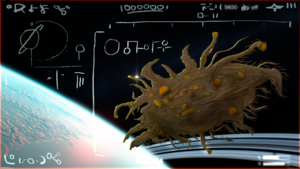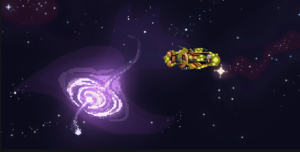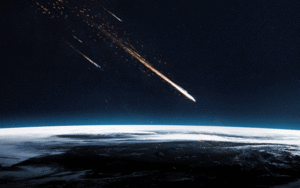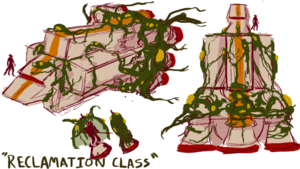Dionae History: Difference between revisions
| (24 intermediate revisions by 5 users not shown) | |||
| Line 1: | Line 1: | ||
{{Navbox Lore}} | {{Navbox Lore}} | ||
{{Navbox_Dionae_Lore}} | {{Navbox_Dionae_Lore}} | ||
{{toc_right}} | |||
==History== | ==History== | ||
The enigmatic species, Dionae, have been discovered in various different locations throughout the Orion Spur. With a history unlike any other, with myriads of different perspectives and thousands of years of experiences culminating into what is known today, it was inevitable that there would be different viewpoints of the discovery of the Dionae with each species. | |||
==Skrell History== | |||
===First Discovery=== | ===First Discovery=== | ||
[[File:DionaeCap.PNG|thumb|alt=First Discovery.|The first discovery of the Dionae lead to a rush for rare minerals collected by their mass.]] | |||
It is speculated that the species was initially discovered by [[Skrell]] prospectors on an arctic planetoid within the Xelp System. Originally sent to Xelp III to locate minerals that could aid in the reconstruction of Qerrbalak, but instead discovered concentrated and condensed metals shrouded by weeds. The discovery prompted the ‘Gold Rush’ of the '''2190s CE''' with thousands pouring their efforts into searching for more of the refined and compressed metals, climaxing in '''2198 CE''' when it could no longer be located throughout the planet. It is now suspected that the Skrell had caused an Echion Colossus to perish during the Gold Rush. | |||
===Skrell Discovery=== | ===Skrell Discovery=== | ||
The first documented discovery of | The first documented discovery of the species occurred in '''2217 CE'''. A [[Skrell]] Exploratory Vessel noted an inconsistency with data taken from a scan of the Neuron Star - Kelo’Hen. It was soon labelled as an astrological anomaly, prompting further investigation after the discovery of an organic celestial body orbiting Kelo’Hen IIa. Whilst the loggings indicate a massive hull breach occurred shortly after first contact. | ||
The destruction of the vessel sent shockwaves throughout the Nralakk Federation - many theorising that Glorsh-Omega had returned after a period of hibernation. The recovering nation quickly dispatched a small fleet of cruisers to be attached to a rescue operation. Upon entering the system, they were welcomed by a now overgrown derelict, filled with an unknown organic growth. Initially believed to be some kind of parasite, the [[Skrell]] outfitted themselves with the appropriate gear to investigate the derelict exploratory vessel. | |||
The operation perforated the derelict, discovering the dozens of hull breaches. As they pushed deeper into the vessel, it became apparent that there were no signs of the deceased crew. Although this gave rise to the hope that they had managed to utilize the escape pods, it soon proved to be false hope as they located the untouched pods. Additional analysis yielded that the growth was in fact flora - one that could survive in the clutches of space - and thus samples were taken. | |||
[[File:SkrellDionae.png|thumb|alt=First Discovery.|The first-ever documented discovery of the Dionae was simply tagged as an anomaly in astrological data.]] | [[File:SkrellDionae.png|thumb|alt=First Discovery.|The first-ever documented discovery of the Dionae was simply tagged as an anomaly in astrological data.]] | ||
Upon their return, it was discovered that a stowaway had managed to cling onto some gear - a small worm-like creature that shared characteristics with the growth located within the confines of the derelict. Initially believed to be a non sapient creature of the void, it was only after it had begun utilizing various chirps, and incoherent sentences in Nral’Malik, that the team began to understand the gravity of the situation at hand. Almost immediately, it was contained and transported to the nearest scientific asset for it to be studied. | |||
The | The project was deemed confidential, with the reasoning for the destruction of the derelict simply cited as a massive solar flare decimating the electronics - further leading to a catastrophic failure of life-sustaining machines. After covering up the destruction, the Grand Council proceeded to select very choice Biologists, Botanists and Linguists to investigate the creature, and whether a language could be deciphered. It was Linguistics Professor Xuq’mqix Volq that successfully constructed the Xuq Translator, a machine only capable of being described as a Skrell Enigma Machine. | ||
The | The creation of the Xuq Translator allowed for crude, but coherent communication to occur between the singular nymph, and the Skrell. In horrific detail, the creature describes the acts committed against and within the exploratory vessel but reassured that after the deceased Skrell had assimilated into the conglomerate that they understood the weight of their actions. The species was soon dubbed Dionae Primis, after a similar species on Qerrbalak that had parasitic qualities. With the use of the Xuq Translator, the remainder of the Dionae were contacted. It was established that the Dionae would be rerouted to the Nrallak Star System, where they could commence additional diplomatic engagements. The entirety of the cluster promptly agreed, and navigated through the stars to where it remains today as the [[Minor_Dionae_Factions#The_Conglomerated_Choir_of_Nralakk_-_Nralakk_Federation|Conglomerated Choir of Nralakk.]] | ||
===Skrell Aftermath=== | ===Skrell Aftermath=== | ||
After the | After the Dionae the operation had become declassified, the cultural shockwave it had on [[Skrell]] society was enormous. Hundreds of different theories expanded across the species - some believing the Dionae wish to harm them, whilst others believing that the discovery of an alien species was inevitable, and they should be welcomed. Formal recognition of the species' [[Diona_in_the_Federation|integration]] into the Nralakk Federation was made in '''2240 CE''' when the species had its contributions to the reconstruction of the Federation recognised. | ||
Dionae and Skrell have since formed | Dionae and [[Skrell]] have since formed an inseparable bond. The Skrell provide the Dionae with resources necessary for reproduction, as well as for the development of places of living, which the Dionae repay by contributing their efforts to assist in the Federation’s expansion across the stars. Another byproduct of this relationship is an order to destroy a theoretical form of the Dionae, noted to as a [https://wiki.aurorastation.org/index.php?title=Dionae_Forms#Titan| Titan], due to the inherent risk of intelligence singularity and other classified risks. | ||
Another byproduct of this relationship is an order to destroy a theoretical form of the Dionae, noted to as a [https://wiki.aurorastation.org/index.php?title=Dionae_Forms#Titan| Titan], due to the inherent risk of intelligence singularity and other classified risks. | |||
==Human History== | |||
===First Discovery=== | ===First Discovery=== | ||
It is believed that the Dionae were first discovered by humanity during the Great Interstellar War, within the Weeping Stars Region on the Orion Spur. Numerous auxiliary fleets seemed to have stumbled upon a now derelict Battleship, within 1.2 parsecs of the war’s deadliest assault - The Battle of the Binary. The auxiliary fleet further investigated the derelict, noting the existence of an abnormal growth of the starboard bow. Initially, it was thought that the Battleship had been destroyed by Coalition Forces, however, after preliminary scans it was observed that the derelict had become a breeding ground of sorts for extraterrestrial fauna. The auxiliary fleets eventually disembarked, leaving the vessel to be engulfed by the red giant it orbited. | |||
===Human Discovery=== | ===Human Discovery=== | ||
See: [[Rueltab]] | |||
Almost a decade after the discovery of [[Skrell]] by Humanity, a joint operation had been initiated. The respective operation had been alerted to an astrological anomaly similar to the one noted in Kelo’Hen before it was discovered to be the Dionae. The possibility turned into reality as a new cluster was unearthed - just as the operation entered the Rueltab System on '''July 18th 2378 CE'''. | |||
The | The [[Skrell]] forewarned that proximity was important - as getting too close to the Dionae may prompt them to become hostile. Whilst the Xuq Translator was being prepared, the Cluster began rapidly navigating through the void - with onlookers stating it was almost as if the species were capable of manipulating its surroundings. It pounced on a [[Sol Alliance|Solarian]] vessel, known as the Ophion, causing multiple hull breaches which ultimately prompted the overload of the warp core - an explosion echoed and acted an electromagnetic pulse to any ships within a ten-kilometre squared radius of the explosion. With most of the joint operation being damaged one way or another, they were forced to retreat into more civilised segments of the Orion Spur - dubbing the event the “Rueltab Incident.” | ||
[[File:DionaeCaelphon.png|thumb|alt=SASV Ophion.|The SASV Ophion was abandoned shortly after a Dionae assault on the vessel.]] | [[File:DionaeCaelphon.png|thumb|alt=SASV Ophion.|The SASV Ophion was abandoned shortly after a Dionae assault on the vessel.]] | ||
After the exponential damage done to the operation, it was deemed necessary for additional firepower to be sent. Upon entering the Rueltab System, the fleets were welcomed to a similar sight experienced by the [[Skrell]] a century earlier - an overgrown derelict that replaced the Ophion. Armed with knowledge on how to circumvent the possibility of hostilities, they fired upon the cluster as a preventative measure. | |||
The talks | The talks would continue for over a year - with a blockade of the system being placed to prevent unnecessary interruption. The assimilation of the crew aboard the Ophion assisted greatly giving the Dionae an inkling of the culture, and the language, that the Solarians had. The Dionae were soon ‘arrested’ for their crimes against the [[Sol Alliance]] and were almost immediately integrated into menial labour, where they were expected to pay their debt to the Alliance - usually taking a decade or more to do so. | ||
===Human Aftermath=== | ===Human Aftermath=== | ||
The tragedy of the Ophion is still considered the greatest example of why the Dionae should be kept under close monitoring. Decades following the incident, the Dionae would have regulations and restrictions placed on them - essentially being classed as residents, but not citizens, of the Solarian Alliance. Many were sent to [https://wiki.aurorastation.org/index.php?title=New_Gibson| New Gibson], to strip mine the planet - and assist in developing it as a major-industrial powerhouse in the '''Middle-Ring''' of the [[Sol Alliance]]. Their survival only being guaranteed by the various electronics designed to provide light, and the majority of the radioactive waste produced on New Gibson being sent to the sizable community. | |||
= | Those who had paid their debt to the Solarians resettled themselves to [https://wiki.aurorastation.org/index.php?title=Biesel| Biesel] eventually leading to the commencement of the construction of the Eternal Temple in '''2382 CE'''. It became a beacon for all Dionae, to continue to strive and work hard for the eventual taste of freedom. It took nearly sixty years for the Temple to be completed, finally being unveiled as a whole in '''2431 CE'''. [https://wiki.aurorastation.org/index.php?title=Notable_Dionae| Connected to the Blossoms Beyond] was one of the first to resettle, being granted rights to a rather large piece of land considered to not be of any value to the [[Sol Alliance]], which would eventually become the one of the largest [https://wiki.aurorastation.org/index.php?title=Dionae_Clusters#The_Eternal_Temple| community] of Dionae a century later. | ||
==Unathi History== | |||
===First Discovery=== | ===First Discovery=== | ||
[[File:DionaeHistory1.gif|thumb|alt=Unathi First Discovery.|The first Unathi discovery was merely the watching of a meteor shower, later discovered to be Dionae seeds.]] | [[File:DionaeHistory1.gif|thumb|alt=Unathi First Discovery.|The first Unathi discovery was merely the watching of a meteor shower, later discovered to be Dionae seeds.]] | ||
Various clans littered across the northern wastelands of Moghes saw thousands of streaks descend from the skies - a beauty not commonly seen in the horrific conditions known to most. What was in fact not shooting stars, but thousands of Dionae seeds entering the atmosphere. Whilst some theorise that they hitchhiked a meteorite, others have speculated that other species across the Orion Spur delivered the payload to assist in pushing back the immense expanse of continued growth across Moghes - The Wasteland. | |||
===Unathi Discovery=== | ===Unathi Discovery=== | ||
Several months after the supposed meteorite shower, an area previously just a crater spanning over two kilometres in diameter, had become an Oasis. No longer did an irradiated lake ruminate within the centre, but a source of freshwater that allowed its surroundings to once again bloom with biodiversity. The nomads of the wastes stumbled upon the ever-growing number of these areas - all previously deemed uninhabitable, but now sprouted full of life. Many ‘colonising’ these areas, and settling their tribes within the now flourishing segments of the Wastelands. | |||
[[File:Reclaimation.png|thumb|alt=Dionae Unathi.|The Dionae have since been used by various Unathi - even Reclaimers.]] | [[File:Reclaimation.png|thumb|alt=Dionae Unathi.|The Dionae have since been used by various Unathi - even Reclaimers.]] | ||
Upon further investigation, these miracles were in fact not just miracles. It was discovered that hundreds of little worm-like creatures would cement themselves within the most irradiated segments of the wastes, leaving the area only once the radiation levels dropped. The Unathi slowly came to understand that these creatures were in fact behind the restoration of the wastes - leading many to capture them in hopes of focusing their effort. It wasn't until communication was established between the species (thanks to assimilating the corpses of the Unathi). The relationship prospered - the Dionae extracted the radiation within the Wastelands, in return for being cared for by the Unathi. A symbiotic relationship, where each relied on another for further prosperity. | |||
The | |||
===Unathi Aftermath=== | ===Unathi Aftermath=== | ||
The two live in a state of symbiosis - With Unathi that are confined to the wastes relying on the species in order to expand their influence, and means of agriculture, through the radiated areas. Some Dionae have even been inducted into various tribes, being treated as equals in the eyes of the Unathi. Sk’akh followers have even hailed them as blessings from Sk’akh, allowing for Dionae to easily integrate within Unathi society. | |||
==Recent History== | |||
In recent times, the species has undergone massive advancements. Not only have they integrated into most societies across the Orion Spur - but have even begun expanding their reaches and colonising planets themselves. | |||
[[Category:Dionaea]] | |||
Latest revision as of 07:22, 15 August 2024
| Dionae Lore Pages | ||
|---|---|---|
| Species | Dionae · Dionae Forms · Dionae Mindtypes · Dionae Biology · Dionae Out-Of-Character | |
| Locations, Planets & Systems | Xrim · Hieroaetheria · Rueltab · Primitive Sirens of Mictlan · Eternal Gardens | |
| Conglomerates & Factions | Liberty's Cluster · Dionae in the Federation · Dionae in the Hegemony · Vaurcae & Dionae · The Narrows · The Underhive Collective · Pactolus Exploration League · The Voidtamer Confluence | |
| Culture, History & Society | Dionae Culture · Notable Dionae · Dionae Space Capabilities · Dionae History · The Eternal | |
| Lore Arcs | Omnivirate's Providence · Magna Expansio Unionis · They Who Hath Become Lord | |
History
The enigmatic species, Dionae, have been discovered in various different locations throughout the Orion Spur. With a history unlike any other, with myriads of different perspectives and thousands of years of experiences culminating into what is known today, it was inevitable that there would be different viewpoints of the discovery of the Dionae with each species.
Skrell History
First Discovery

It is speculated that the species was initially discovered by Skrell prospectors on an arctic planetoid within the Xelp System. Originally sent to Xelp III to locate minerals that could aid in the reconstruction of Qerrbalak, but instead discovered concentrated and condensed metals shrouded by weeds. The discovery prompted the ‘Gold Rush’ of the 2190s CE with thousands pouring their efforts into searching for more of the refined and compressed metals, climaxing in 2198 CE when it could no longer be located throughout the planet. It is now suspected that the Skrell had caused an Echion Colossus to perish during the Gold Rush.
Skrell Discovery
The first documented discovery of the species occurred in 2217 CE. A Skrell Exploratory Vessel noted an inconsistency with data taken from a scan of the Neuron Star - Kelo’Hen. It was soon labelled as an astrological anomaly, prompting further investigation after the discovery of an organic celestial body orbiting Kelo’Hen IIa. Whilst the loggings indicate a massive hull breach occurred shortly after first contact.
The destruction of the vessel sent shockwaves throughout the Nralakk Federation - many theorising that Glorsh-Omega had returned after a period of hibernation. The recovering nation quickly dispatched a small fleet of cruisers to be attached to a rescue operation. Upon entering the system, they were welcomed by a now overgrown derelict, filled with an unknown organic growth. Initially believed to be some kind of parasite, the Skrell outfitted themselves with the appropriate gear to investigate the derelict exploratory vessel.
The operation perforated the derelict, discovering the dozens of hull breaches. As they pushed deeper into the vessel, it became apparent that there were no signs of the deceased crew. Although this gave rise to the hope that they had managed to utilize the escape pods, it soon proved to be false hope as they located the untouched pods. Additional analysis yielded that the growth was in fact flora - one that could survive in the clutches of space - and thus samples were taken.

Upon their return, it was discovered that a stowaway had managed to cling onto some gear - a small worm-like creature that shared characteristics with the growth located within the confines of the derelict. Initially believed to be a non sapient creature of the void, it was only after it had begun utilizing various chirps, and incoherent sentences in Nral’Malik, that the team began to understand the gravity of the situation at hand. Almost immediately, it was contained and transported to the nearest scientific asset for it to be studied.
The project was deemed confidential, with the reasoning for the destruction of the derelict simply cited as a massive solar flare decimating the electronics - further leading to a catastrophic failure of life-sustaining machines. After covering up the destruction, the Grand Council proceeded to select very choice Biologists, Botanists and Linguists to investigate the creature, and whether a language could be deciphered. It was Linguistics Professor Xuq’mqix Volq that successfully constructed the Xuq Translator, a machine only capable of being described as a Skrell Enigma Machine.
The creation of the Xuq Translator allowed for crude, but coherent communication to occur between the singular nymph, and the Skrell. In horrific detail, the creature describes the acts committed against and within the exploratory vessel but reassured that after the deceased Skrell had assimilated into the conglomerate that they understood the weight of their actions. The species was soon dubbed Dionae Primis, after a similar species on Qerrbalak that had parasitic qualities. With the use of the Xuq Translator, the remainder of the Dionae were contacted. It was established that the Dionae would be rerouted to the Nrallak Star System, where they could commence additional diplomatic engagements. The entirety of the cluster promptly agreed, and navigated through the stars to where it remains today as the Conglomerated Choir of Nralakk.
Skrell Aftermath
After the Dionae the operation had become declassified, the cultural shockwave it had on Skrell society was enormous. Hundreds of different theories expanded across the species - some believing the Dionae wish to harm them, whilst others believing that the discovery of an alien species was inevitable, and they should be welcomed. Formal recognition of the species' integration into the Nralakk Federation was made in 2240 CE when the species had its contributions to the reconstruction of the Federation recognised.
Dionae and Skrell have since formed an inseparable bond. The Skrell provide the Dionae with resources necessary for reproduction, as well as for the development of places of living, which the Dionae repay by contributing their efforts to assist in the Federation’s expansion across the stars. Another byproduct of this relationship is an order to destroy a theoretical form of the Dionae, noted to as a Titan, due to the inherent risk of intelligence singularity and other classified risks.
Human History
First Discovery
It is believed that the Dionae were first discovered by humanity during the Great Interstellar War, within the Weeping Stars Region on the Orion Spur. Numerous auxiliary fleets seemed to have stumbled upon a now derelict Battleship, within 1.2 parsecs of the war’s deadliest assault - The Battle of the Binary. The auxiliary fleet further investigated the derelict, noting the existence of an abnormal growth of the starboard bow. Initially, it was thought that the Battleship had been destroyed by Coalition Forces, however, after preliminary scans it was observed that the derelict had become a breeding ground of sorts for extraterrestrial fauna. The auxiliary fleets eventually disembarked, leaving the vessel to be engulfed by the red giant it orbited.
Human Discovery
See: Rueltab
Almost a decade after the discovery of Skrell by Humanity, a joint operation had been initiated. The respective operation had been alerted to an astrological anomaly similar to the one noted in Kelo’Hen before it was discovered to be the Dionae. The possibility turned into reality as a new cluster was unearthed - just as the operation entered the Rueltab System on July 18th 2378 CE.
The Skrell forewarned that proximity was important - as getting too close to the Dionae may prompt them to become hostile. Whilst the Xuq Translator was being prepared, the Cluster began rapidly navigating through the void - with onlookers stating it was almost as if the species were capable of manipulating its surroundings. It pounced on a Solarian vessel, known as the Ophion, causing multiple hull breaches which ultimately prompted the overload of the warp core - an explosion echoed and acted an electromagnetic pulse to any ships within a ten-kilometre squared radius of the explosion. With most of the joint operation being damaged one way or another, they were forced to retreat into more civilised segments of the Orion Spur - dubbing the event the “Rueltab Incident.”

After the exponential damage done to the operation, it was deemed necessary for additional firepower to be sent. Upon entering the Rueltab System, the fleets were welcomed to a similar sight experienced by the Skrell a century earlier - an overgrown derelict that replaced the Ophion. Armed with knowledge on how to circumvent the possibility of hostilities, they fired upon the cluster as a preventative measure.
The talks would continue for over a year - with a blockade of the system being placed to prevent unnecessary interruption. The assimilation of the crew aboard the Ophion assisted greatly giving the Dionae an inkling of the culture, and the language, that the Solarians had. The Dionae were soon ‘arrested’ for their crimes against the Sol Alliance and were almost immediately integrated into menial labour, where they were expected to pay their debt to the Alliance - usually taking a decade or more to do so.
Human Aftermath
The tragedy of the Ophion is still considered the greatest example of why the Dionae should be kept under close monitoring. Decades following the incident, the Dionae would have regulations and restrictions placed on them - essentially being classed as residents, but not citizens, of the Solarian Alliance. Many were sent to New Gibson, to strip mine the planet - and assist in developing it as a major-industrial powerhouse in the Middle-Ring of the Sol Alliance. Their survival only being guaranteed by the various electronics designed to provide light, and the majority of the radioactive waste produced on New Gibson being sent to the sizable community.
Those who had paid their debt to the Solarians resettled themselves to Biesel eventually leading to the commencement of the construction of the Eternal Temple in 2382 CE. It became a beacon for all Dionae, to continue to strive and work hard for the eventual taste of freedom. It took nearly sixty years for the Temple to be completed, finally being unveiled as a whole in 2431 CE. Connected to the Blossoms Beyond was one of the first to resettle, being granted rights to a rather large piece of land considered to not be of any value to the Sol Alliance, which would eventually become the one of the largest community of Dionae a century later.
Unathi History
First Discovery

Various clans littered across the northern wastelands of Moghes saw thousands of streaks descend from the skies - a beauty not commonly seen in the horrific conditions known to most. What was in fact not shooting stars, but thousands of Dionae seeds entering the atmosphere. Whilst some theorise that they hitchhiked a meteorite, others have speculated that other species across the Orion Spur delivered the payload to assist in pushing back the immense expanse of continued growth across Moghes - The Wasteland.
Unathi Discovery
Several months after the supposed meteorite shower, an area previously just a crater spanning over two kilometres in diameter, had become an Oasis. No longer did an irradiated lake ruminate within the centre, but a source of freshwater that allowed its surroundings to once again bloom with biodiversity. The nomads of the wastes stumbled upon the ever-growing number of these areas - all previously deemed uninhabitable, but now sprouted full of life. Many ‘colonising’ these areas, and settling their tribes within the now flourishing segments of the Wastelands.

Upon further investigation, these miracles were in fact not just miracles. It was discovered that hundreds of little worm-like creatures would cement themselves within the most irradiated segments of the wastes, leaving the area only once the radiation levels dropped. The Unathi slowly came to understand that these creatures were in fact behind the restoration of the wastes - leading many to capture them in hopes of focusing their effort. It wasn't until communication was established between the species (thanks to assimilating the corpses of the Unathi). The relationship prospered - the Dionae extracted the radiation within the Wastelands, in return for being cared for by the Unathi. A symbiotic relationship, where each relied on another for further prosperity.
Unathi Aftermath
The two live in a state of symbiosis - With Unathi that are confined to the wastes relying on the species in order to expand their influence, and means of agriculture, through the radiated areas. Some Dionae have even been inducted into various tribes, being treated as equals in the eyes of the Unathi. Sk’akh followers have even hailed them as blessings from Sk’akh, allowing for Dionae to easily integrate within Unathi society.
Recent History
In recent times, the species has undergone massive advancements. Not only have they integrated into most societies across the Orion Spur - but have even begun expanding their reaches and colonising planets themselves.







